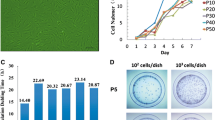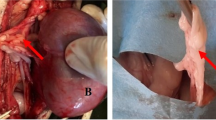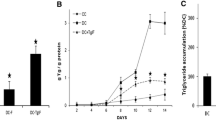Abstract
The study was conducted to know and investigate the mechanism involved during mesenchymal to epithelial transition to unravel questions related to mammary gland development in prepubertal Korean black goat. We, therefore, biopsied mammary fat pad and isolated adipose cells and characterized with stemness factors (CD34, CD13, CD44, CD106, and vimentin) immunologically and through their genetic expression. Furthermore, characterized cells were differentiated to adipogenic (thiazolidinediones and α-linolenic acid) and epithelial (keratinocyte growth factor) lineages. Thiazolidinediones/or in combination with α-linolenic acid demonstrated significant upregulation of adipo-Q, PPAR-γ, CEBP-α, LPL, and resistin. Adipose stem cells in induction mixture (5 μg/ml insulin, 1 μg/ml hydrocortisone, and 10 ng/ml epidermal growth factor) and subsequent treatment with 10 ng/ml keratinocyte growth factor revealed their trans-differentiating ability to epithelial lineage. From 2 d onwards, the cells under keratinocyte growth factor influenced cells to assume rectangular (2–4 d) to cuboidal (8–10 d) shapes. Ayoub–Shklar stain developed brownish-red pigment in the transformed cells. Though, expressions of K8 and K18 were noted to be highly significant (p < 0.01) but expressions of epithelial membrane antigens and epithelial specific antigens were also significant (p < 0.05) compared to 0 d. Conclusively, epithelial transformations of mammary adipose stem cells would add up knowledge to develop therapeutic regimen to deal with mammary tissue injury and diseases.






Similar content being viewed by others
References
Abdanipour A.; Tiraihi T.; Delshad A. Transdifferentiation of the adipose tissue-derived stem cells into neuron-like cells expressing neurotrophins by selegiline. Iran Biomed. J. 15: 113–121; 2011.
Andreadis S. T.; Hamoen K. E.; Yarmush M. L.; Morgan J. R. Keratinocyte growth factor induces hyperproliferation and delays differentiation in a skin equivalent model system. FASEB J. 15: 898–906; 2001.
Arumugam S. B.; Trentz O. A.; Arikketh D.; Senthinathan V.; Rosario B.; Mohandas P. V. A. Detection of embryonic stem cell markers in adult human adipose tissue-derived stem cells. Indian J. Pathol. Microbiol. 54: 501–508; 2011.
Baer P. C.; Bereiter-Hahn J.; Missler C. et al. Conditioned medium from renal tubular epithelial cells initiates differentiation of human mesenchymal stem cells. Cell Proliferation 42: 29–37; 2009.
Baer P. C.; Geiger H. Adipose-derived mesenchymal stromal/stem cells: tissue localization, characterization, and heterogeneity, stem cells international, doi:10.1155/2012/812693; 2012.
Barber M. C.; Travers M. T.; Finley E.; Flint D. J.; Vermon R. G. Growth-hormone-prolactin interactions in the regulation of mammary and adipose-tissue acetyl-CoA carboxylase activity and gene expression in lactating rats. Biochem. J. 285: 469–475; 1992.
Bunnell B. A.; Flaat M.; Gagliardi C.; Patel B.; Ripoll C. Adipose-derived stem cells: isolation, expansion, and differentiation. Methods. 45: 115–120; 2008.
Cano A.; Perez-Moreno M. A.; Rodrigo I.; Locascio A.; Blanco M. J.; del Barrio M. G.; Portillo F.; Nieto M. A. The transcription factor snail controls epithelialmesenchymal transitions by repressing E-cadherin expression. Nat. Cell Biol. 2: 76–83; 2000.
Carvalho A. M.; Alves A. L. G.; Golim M. A.; Moroz A. Isolation and immunophenotypic characterization of mesenchymal stem cells derived from equine species adipose tissue. Vet. Immunol. Immunopathol. 132: 303–306; 2009.
Cinti S. Reversible physiological transdifferentiation in the adipose organ. Proc. Nutr. Soc. 68: 340–349; 2009.
Clayton H.; Titley I.; dM. Vivanco, M. Growth and differentiation of progenitor/stem cells derived from the human mammary gland. Exp. Cell Res. 297: 444–460; 2004.
Deckelbaum R. J.; Worgall T. S.; Seo T. n-3 Fatty acids and gene expression. Am. J. Clin. Nutr. 83(6 suppl): 1520–1525; 2006.
Dontu G.; Abdallah W. M.; Foley J. M.; Jackson K. W.; Clarke M. F.; Kawamura M. J.; Wicha M. S. In vitro propagation and transcriptional profiling of human mammary stem/progenitor cells. Genes Dev. 17: 1253–1270; 2003.
Drasin D.; Robin T. P.; Ford H. L. Breast cancer epithelial-to-mesenchymal transition: examining the functional consequences of plasticity. Breast Cancer Res. 13: 226; 2011.
Dubois-Marshall S.; Thomas J. S.; Faratian D.; Harrison D. J.; Katz E. Two possible mechanisms of epithelial to mesenchymal transition in invasive ductal breast cancer. Clin Exp Metastasis. 28: 811–818; 2011.
Edmond J. Essential polyunsaturated fatty acids and the barrier to the brain: the components of a model for transport. J. Mol. Neurosci. 16: 181–193; 2001.
Fukiage K.; Aoyama T.; Shibata K. R. et al. Expression of vascular cell adhesion molecule-1 indicates the differentiation potential of human bone marrow stromal cells. Biochem. Biophys. Res. Commun. 365: 406–412; 2008.
Gomperts B. N.; Belperio J. A.; Fishbein M. C.; Keane M. P.; Burdick M. D.; Strieter R. M. Am. J. Respir. Cell Mol. Biol. 37: 48–57; 2007.
Green H.; Kehinde O. Sublines of mouse 3T3 cells that accumulate lipid. Cell 1: 113–116; 1974.
Gronthos S.; Franklin D. M.; Leddy H. A.; Robey P. G.; Storms R. W.; Gimble J. M. Surface protein characterization of human adipose tissue-derived stromal cells. J. Cell. Physiol. 189: 54–63; 2001.
Hanley W. D.; Burdick M. M.; Konstantopoulos K.; Sackstein R. CD44 on LS174T colon carcinoma cells possesses E-selectin ligand activity. Cancer Res. 65: 5812–5817; 2005.
Jeffrey M. G.; Katz A. J.; Bunnell B. A. Adipose-derived stem cells for regenerative medicine. Circ. Res. 100: 1249–1260; 2007.
Jones J. R.; Barrick C.; Kim K. A.; Lindner J.; Blondeau B.; Fujimoto Y.; Shiota M.; Kesterson R. A.; Khan B. B.; Magnuson M. A. Deletion of PPAR-gamma in adipose tissues of mice protects against high fat diet-induced obesity and insulin resistance. Proc. Natl. Acad. Sci. U. S. A. 102: 6207–6212; 2005.
Jung E. M.; Kwon O.; Kwon K. S. et al. Evidences for correlation between the reduced VCAM-1 expression and hyaluronan synthesis during cellular senescence of human mesenchymal stem cells. Biochem. Biophys. Res. Commun. 404: 463–469; 2011.
Katz A. J.; Tholpady A.; Tholpady S. S.; Shang H.; Ogle R. C. Cell surface and transcriptional characterization of human adipose-derived adherent stromal (hADAS) cells. Stem Cells 23: 412–423; 2005.
Khan W. S.; Tew S. R.; Adesida A. B. et al. Human infrapatellar fat pad-derived stem cells express the pericyte marker 3G5 and show enhanced chondrogenesis after expansion in fibroblast growth factor-2. Arthritis Res. Ther. 10: 74; 2008.
Kolf C. M.; Cho E.; Tuan R. S. Mesenchymal stromal cells. Biology of adult mesenchymal stem cells: regulation of niche, self-renewal, and differentiation. Arthritis Res. Ther. 9: 204; 2007.
Kundrotas G. Surface markers distinguishing mesenchymal stem cells from fibroblasts. Acta Medica Lituanica. 19(1): 75–79; 2012.
Lee J. M.; Dedhar S.; Kalluri R.; Thompson E. W. The epithelial–mesenchymal transition: new insights in signaling, development, and disease. J. Cell Biol. 172: 973–981; 2006.
Li H.; Zimmerlin L.; Marra K. G. et al. Adipogenic potential of adipose stem cell subpopulations. Plast. Reconstr. Surg. 128: 663–672; 2011.
Liu W.; Li R.; Dou K. F. Convenient and efficient enrichment of the CD133+ liver cells from rat fetal liver cells as a source of liver stem/progenitor cells. Stem Cell Rev 7(1): 94–102; 2011.
Long J. L.; Zuk P.; Berke G. S.; Chhetri D. K. Epithelial differentiation of adipose-derived stem cells for laryngeal tissue engineering. Laryngoscope 120: 125–131; 2010.
Luu H. H.; Zhang R.; Haydon R. C.; Rayburn E.; Kang Q.; Si W.; Park J. K.; Wang H.; Peng Y.; Jiang W.; He T. C. Wnt/β-catenin signaling pathway as novel cancer drug targets. Curr. Cancer Drug Targets 4: 653–671; 2004.
Mani S. A.; Guo W.; Liao M. J.; Eaton E. N.; Ayyanan A.; Zhou A. Y.; Brooks M.; Reinhard F.; Zhang C. C.; Shipitsin M.; Campbell L. L.; Polyak K.; Brisken C.; Yang J.; Weinberg R. A. The epithelial–mesenchymal transition generates cells with properties of stem cells. Cell 133: 704–715; 2008.
McNeil M. Adiopocyte staining with Oil-Red-O. Pennington Laboratory, Molecular Endocrinology, Pennington Biomedical Research Centre, Baton Rouge, LA; 2005.
Micalizzi D. S.; Farabaugh S. M.; Ford H. L. Epithelial–mesenchymal transition in cancer: parallels between normal development and tumor progression. J. Mammary Gland Biol. Neoplasia 15: 117–134; 2010.
Mina-Osorio P.; Winnicke B.; O’Connor C.; Grant C. L.; Vogel L. K.; Rodriguez-Pinto D. et al. CD13 is a noval mediator of monocytic/endothelial cell adhesion. J. Leukoc Biol. 84: 448–459; 2008.
Morel A. P.; Lievre M.; Thomas C.; Hinkal G.; Ansieau S.; Puisieux A. Generation of breast cancer stem cells through epithelial–mesenchymal transition. PLoS One 3: 2888; 2008.
Napier S. L.; Healy Z. R.; Schnaar R. L.; Konstantopoulos K. Selectin ligand expression regulates the initial vascular interactions of colon carcinoma cells: the roles of CD44v and alternative sialofucosylated selectin ligands. J. Biol. Chem. 282: 3433–3441; 2007.
Ooi Y. Y.; Ramasamy R.; Vidyadaran S. Mouse bone marrow mesenchymal stem cells acquire CD45- CD106+ immunophenotype only at later passages. Med. J. Malaysia 63: 65–6; 2008.
Ouji Y.; Yoshikawa M.; Shirol A.; Ishizaka S. Wnt-10b secreted from lymphocytes promotes differentiation of skin epithelial cells. Biochem. Biophys. Res. Commun. 342: 1063–1069; 2006.
Qi K.; Hall M.; Deckelbaum R. J. Long-chain polyunsaturated fatty acid accretion in brain. Curr. Opin. Clin. Nutr. Metab. Care 5: 133–138; 2002.
Ren Y.; Wu H.; Zhou X.; Wen J.; Jin M.; Cang M.; Guo X.; Wang Q.; Liu D.; Ma Y. Isolation, expansion, and differentiation of goat adipose-derived stem cells. Res. Vet. Sci. 93: 404–411; 2012.
Rodeheffer M. S.; Birsoy K.; Friedman J. M. Identification of white adipocyte progenitor cells in vivo. Cell 135: 240–249; 2008.
Sampath H. Polyunsaturated fatty acid regulation of genes of lipid metabolism. Annu. Rev. Nutr. 25: 317–340; 2005.
Singh N. K.; Kinjavdekar P.; Amarpal S.; Singh G. R.; Pratap K. Evaluation of epidural xylazine and ketamine for the management of post-traumatic pain in goats. Indian J. Vet. Surg. 22(2): 73–78; 2001.
Sotiropoulou P. A.; Perez S. A.; Salagianni M.; Baxevanis C. N.; Papamichail M. Characterization of the optimal culture conditions for clinical scale production of human mesenchymal stem cells. Stem Cells. 24: 462–471; 2006.
Suga H.; Shigeura T.; Inoue K.; Kato H.; Aoi N.; Murase S.; Sato K.; Gonda K.; Koshima I.; Yoshimura K. Rapid expansion of human adipose derived stromal cells preserving multipotency. Cytotherapy 9: 738–745; 2007.
Szpirer C.; Riviere M.; Cortese R.; Nakamura T.; Islam M. Q.; Levan G.; Szpirer J. Chromosomal localization in man and rat of the genes encoding the liver-enriched transcription factors C/EBP, DBP and HNF1/LFB-1 (CEBP, DBP, and transcription factor 1, TCF1, respectively) and of the hepatocyte growth factor/scatter factor gene (HGF). Genomics 13: 293–300; 1992.
Tapp H.; Hanley Jr. E. N.; Patt J. C.; Gruber H. E. Adipose-derived stem cells: characterization and current application in orthopaedic tissue repair. Exp. Biol. Med. 234: 1–9; 2009.
Thomas S. N.; Zhu F.; Schnaar R. L.; Alves C. S.; Konstantopoulos K. Carcinoembryonic antigen and CD44 variant isoforms cooperate to mediate colon carcinoma cell adhesion to E- and L-selectine in shear flow. J. Biol. Chem. 283: 15647–15655; 2008.
Trimboli A. J.; Fukino K.; de Bruin A.; Wei G.; Shen L.; Tanner S. M.; Creasap N.; Rosol T. J.; Robinson M. L.; Eng C.; Ostrowski M. C.; Leone G. Direct evidence for epithelial–mesenchymal transitions in breast cancer. Cancer Res. 68: 937–945; 2008.
Ukkola O.; Santaniemi M. Adiponectin: a link between excess adiposity and associated comorbidities? J. Mol. Med. 80: 696–702; 2002.
Uzan B.; Figeac F.; Portha B.; Movasasat J. Mechanisms of KGF mediated signaling in pancreatic duct cell proliferation and differentiation. Plos One 4: e4734; 2009.
Varma M. J.; Breuls R. G.; Schouten T. E.; Jurgens W. J.; Bontkes H. J.; Schuurhuis G. J.; van Ham S. M.; van Milligen F. J. Phenotypical and functional characterization of freshly isolated adipose tissue-derived stem cells. Stem Cells Dev. 16: 91–104; 2007.
Vassaux G.; Grel R. N.; Ailhaud G.; Gaillard D. Proliferation and differentiation of rat adipose precursor cells in chemically defined medium: differential action of anti-adipogenic agents. J. Cell. Physiol. 161: 249–256; 1994.
Vidal M.; Kilroy G.; Johnson J.; López M.; Moore R.; Gimble J. Cell growth characteristics and differentiation frequency of adherent equine bone marrow-derived mesenchymal stromal cells: adipogenic and osteogenic capacity. Vet Surg 35: 601–610; 2006.
Vidal M. A.; Walker N. J.; Napoli E.; Borjesson D. L. Evaluation of senescence in mesenchymal stem cells isolated from equine bone marrow, adipose tissue, and umbilical cord tissue. Stem Cells Dev. 21: 273–283; 2012.
Vieira N. M.; Brandalise V.; Zucconi E.; Jazedje T.; Secco M.; Nunes V. A. Human multipotent adipose-derived stem cells restore dystrophin expression of Duchenne skeletal-muscle cells in vitro. Biol. Cell 100: 231–241; 2008.
Wagner W.; Wein F.; Seckinge A. et al. Comparative character-istics of mesenchymal stem cells from human bone marrow, adipose tissue, and umbilical cord blood. Exp. Hematol. 33: 1402–1416; 2005.
Williams K. J.; Picou A. A.; Kish S. L. et al. Isolation and characterization of porcine adipose tissue-derived adult stem cells. Cells Tissues Organs 188: 251–258; 2008.
Yang X. F.; He X.; He J. et al. High efficient isolation and systematic identification of human adipose-derived mesenchymal stem cells. J. Biomed. Sci. 18: 59; 2011.
Zhao C.; Meng L.; Hu H.; Wang X.; Shi F.; Wang Y.; Li Q.; Lin A. Spontaneously immortalized bovine mammary epithelial cells exhibit a distinct gene expression pattern from the breast cancer cells. BMC Cell Biol. 11: 82; 2010.
Acknowledgments
The research was fully supported and facilitated from National Research Foundation of Korea (grant no.120130344) and was partly supported by research grant from Kangwon national University (grant no. 120100910) and (grant no. 120131475).
Author information
Authors and Affiliations
Corresponding author
Additional information
Editor: T. Okamoto
Rights and permissions
About this article
Cite this article
Reza, A.M.M.T., Shiwani, S., Singh, N.K. et al. Keratinocyte growth factor and thiazolidinediones and linolenic acid differentiate characterized mammary fat pad adipose stem cells isolated from prepubertal Korean black goat to epithelial and adipogenic lineage. In Vitro Cell.Dev.Biol.-Animal 50, 194–206 (2014). https://doi.org/10.1007/s11626-013-9690-5
Received:
Accepted:
Published:
Issue Date:
DOI: https://doi.org/10.1007/s11626-013-9690-5




